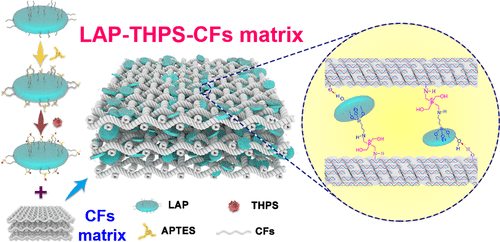当前位置:
X-MOL 学术
›
Biomacromolecules
›
论文详情
Our official English website, www.x-mol.net, welcomes your
feedback! (Note: you will need to create a separate account there.)
Hierarchical Incorporation of Surface-Functionalized Laponite Clay Nanoplatelets with Type I Collagen Matrix
Biomacromolecules ( IF 5.5 ) Pub Date : 2020-12-04 , DOI: 10.1021/acs.biomac.0c01391 Jiabo Shi, Ruizhen Zhang, Na Yang, Yi Zhang, Bradley W. Mansel, Sujay Prabakar, Jianzhong Ma
Biomacromolecules ( IF 5.5 ) Pub Date : 2020-12-04 , DOI: 10.1021/acs.biomac.0c01391 Jiabo Shi, Ruizhen Zhang, Na Yang, Yi Zhang, Bradley W. Mansel, Sujay Prabakar, Jianzhong Ma

|
Unraveling the interaction mechanisms of type I collagen with various inorganic nanoparticles is of pivotal importance to construct collagen-based bionanocomposites with hierarchical structures for biomedical, pharmaceutical, and other industrial applications. In this study, synthetic two-dimensional Laponite nanoplatelets (LAP NPs) are surface-functionalized with tetrakis(hydroxymethyl) phosphonium sulfate (THPS) for reinforcing their incorporation with type I collagen matrix by focusing on the influences of the interactions on the hierarchical structures of the collagen. Our results indicate that the LAP NPs can be successfully surface-functionalized with THPS via covalent bonds between the amine-functionalized NPs and the hydroxymethyl groups of THPS. Moreover, the resulting NPs can be well dispersed into the collagen matrix and evenly bound onto the collagen fiber strands and between the collagen fibrils, preserving the native D-periodic banding patterns of the collagen fibrils. The formation of covalent and hydrogen bonds between the collagen and the functionalized NPs can stabilize the intrinsic triple-helical conformation of the collagen, conferring the resulting collagen-based nanocomposites with improved thermal stability and enhanced mechanical properties. We anticipate that a fundamental understanding of the interactions between the collagen and functionalized inorganic nanoparticles would contribute to the design, fabrication, and further application of hierarchical collagen-based bionanocomposites with multifunctions.
中文翻译:

表面功能化皂石粘土纳米片与I型胶原基质的分层结合
阐明I型胶原蛋白与各种无机纳米粒子的相互作用机理对于构建具有层次结构的胶原蛋白生物纳米复合材料至关重要,对于生物医学,制药和其他工业应用而言。在这项研究中,合成的二维Laponite纳米血小板(LAP NPs)通过四(羟甲基)硫酸phospho(THPS)进行表面功能化,以通过集中于相互作用对结构的层次结构的影响来增强其与I型胶原基质的结合。胶原蛋白。我们的结果表明,LAP NP可以通过胺官能化的NP与THPS的羟甲基之间的共价键成功地被THPS表面官能化。此外,胶原蛋白原纤维的D-周期带型。胶原蛋白和功能化的NP之间共价键和氢键的形成可以稳定胶原蛋白的固有三螺旋构象,从而使所得的基于胶原蛋白的纳米复合材料具有更高的热稳定性和增强的机械性能。我们预计,对胶原蛋白和功能化无机纳米粒子之间相互作用的基本理解将有助于设计,制造和进一步应用具有多功能性的基于胶原蛋白的分层纳米复合材料。
更新日期:2021-02-08
中文翻译:

表面功能化皂石粘土纳米片与I型胶原基质的分层结合
阐明I型胶原蛋白与各种无机纳米粒子的相互作用机理对于构建具有层次结构的胶原蛋白生物纳米复合材料至关重要,对于生物医学,制药和其他工业应用而言。在这项研究中,合成的二维Laponite纳米血小板(LAP NPs)通过四(羟甲基)硫酸phospho(THPS)进行表面功能化,以通过集中于相互作用对结构的层次结构的影响来增强其与I型胶原基质的结合。胶原蛋白。我们的结果表明,LAP NP可以通过胺官能化的NP与THPS的羟甲基之间的共价键成功地被THPS表面官能化。此外,胶原蛋白原纤维的D-周期带型。胶原蛋白和功能化的NP之间共价键和氢键的形成可以稳定胶原蛋白的固有三螺旋构象,从而使所得的基于胶原蛋白的纳米复合材料具有更高的热稳定性和增强的机械性能。我们预计,对胶原蛋白和功能化无机纳米粒子之间相互作用的基本理解将有助于设计,制造和进一步应用具有多功能性的基于胶原蛋白的分层纳米复合材料。











































 京公网安备 11010802027423号
京公网安备 11010802027423号